Bure Valley Railway
The Bure Valley Railway is a 15 in (381 mm) minimum gauge heritage railway in Norfolk
| Bure Valley Railway | |
|---|---|
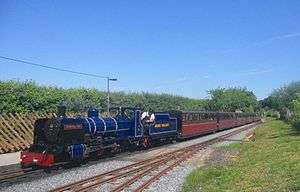 Loco No. 6 'Blickling Hall' and its train arrive at Wroxham | |
| Locale | Wroxham 52.7168°N 1.4084°E |
| Terminus | Aylsham 52.7911°N 1.2548°E |
| Commercial operations | |
| Name | East Norfolk Railway |
| Original gauge | 4 ft 8 1⁄2 in (1,435 mm) standard gauge |
| Preserved operations | |
| Operated by | Bure Valley Railway |
| Stations | 5 |
| Length | 9 mi (14.5 km) |
| Preserved gauge | 15 in (381 mm) |
| Commercial history | |
| Opened | 1880 |
| Closed to passengers | 1952 |
| Closed | 1982 |
| Preservation history | |
| 10 July 1990 | opened |
| Bure Valley Railway | |||||||||||||||||||||||||||||||||||||||||||||||||||||||||||||||||||||||||||||||||||||
|---|---|---|---|---|---|---|---|---|---|---|---|---|---|---|---|---|---|---|---|---|---|---|---|---|---|---|---|---|---|---|---|---|---|---|---|---|---|---|---|---|---|---|---|---|---|---|---|---|---|---|---|---|---|---|---|---|---|---|---|---|---|---|---|---|---|---|---|---|---|---|---|---|---|---|---|---|---|---|---|---|---|---|---|---|---|
| |||||||||||||||||||||||||||||||||||||||||||||||||||||||||||||||||||||||||||||||||||||
The railway runs from Wroxham to Aylsham (9 miles or 14.5 kilometres) and is Norfolk's longest railway of less than standard gauge. It uses both steam and diesel locomotives. There are intermediate halts at Brampton, Buxton and Coltishall. There are 17 bridges, including a 105-foot (32 m)-long girder bridge over the River Bure in Buxton with Lammas, and the Aylsham Bypass Tunnel under the A140 at Aylsham.
History
The railway is built on the trackbed of the East Norfolk Railway (ENR). The ENR started in 1877 when the East Norfolk Railway opened from Norwich to Cromer, with an extension from Wroxham to Aylsham in 1880. The ENR was taken over by the Great Eastern Railway in 1882, which was amalgamated into the London & North Eastern Railway in 1923. The railway was nationalised in 1948.
In 1952 the passenger service stopped, but the freight service continued. Buxton Lamas, as it was then known, closed for goods in 1964, and Aylsham and Coltishall in 1974. Freight trains continued to run over the line after this for two principal sources of traffic. The line west of Aylsham via Cawston and Reepham originally went further to a junction at County School Station; by this time it instead turned south via a new curve at Themelthorpe to join a fragment of the old Midland and Great Northern system to reach Lenwade and Norwich City.
Coal traffic continued to be carried from Norwich Thorpe via Aylsham to Norwich City There was also regular traffic from Lenwade in the form of concrete building components.
This traffic ended in 1981 and the line through Aylsham formally closed on 6 January 1982. A weed-killing train ran in 1983 and track-lifting trains ran the following year.
Re-opening
The Bure Valley Railway opened on 10 July 1990 under the management of RKF Leisure which had purchased the trackbed.[1] When the RKF's parent company, RKF Group Plc, went into receivership in January 1991, Broadland District Council moved quickly to acquire the line from the receivers as it feared that property developers might seize the opportunity to take control of the land.[1] Agreement was reached with Ffestiniog Railway director Mike Hart to set up a new company, Bure Valley Railway (1991) Ltd, to lease and operate the line.[1] A long distance footpath (rail trail) opened alongside it in 1991. It is currently home to Aylsham Bypass Tunnel, Norfolk's only operational railway tunnel, which carries the railway under the Aylsham Bypass replacing the original standard gauge level crossing. Cromer Tunnel in Cromer, the only other surviving railway tunnel in the county, is disused.
Locomotives
| No. | Name | Year built | Livery | Locomotive type | Wheel arr. |
In Traffic? | Image |
|---|---|---|---|---|---|---|---|
| 1 | Wroxham Broad (previously Tracey Jo) | 1964 (converted to a 2-6-4 T in 1992) | Light Blue | Steam | 2-6-4 T | Yes | 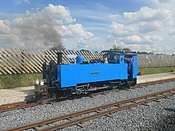 |
| 3 | 2nd Air Division USAAF | 1988 | Golden Ochre | Diesel | Bo-Bo | Yes | 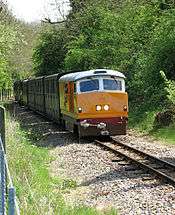 |
| 4 | (Not named) (Unofficially Rusty) |
1954 (rebuilt and regauged 2004) | Orange | Diesel | 4w DH | Yes | 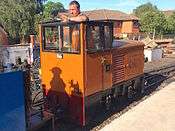 |
| 5 | (Not named)
(Unofficially Toby) |
1960 | Green with red detail | Diesel | 4w DM | Yes | |
| 6 | Blickling Hall | 1994 | Great Eastern Railway Blue | Steam | 2-6-2 | Yes | 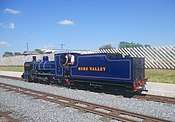 |
| 7 | Spitfire | 1994 | Lined Brunswick Green | Steam | 2-6-2 | No. Withdrawn for Boiler overhaul | 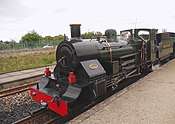 |
| 8 | John of Gaunt (previously Thunder) | 1997 (converted to coal-firing in 2008) | Lined Black | Steam | 2-6-2 T | Yes | 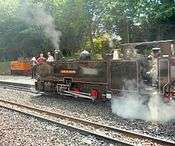 |
| 9 | Mark Timothy | 1993 (rebuilt and converted to coal-firing in 2003) | Madderlake Red | Steam | 2-6-4 T | Yes | 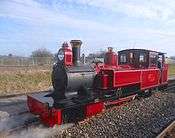 |
When the railway first opened, several locomotives were hired from the Romney, Hythe and Dymchurch Railway, including: Black Prince, Samson and Winston Churchill.
Passenger coaches
Passenger rolling stock consists of 29 vehicles, which are usually marshalled so as to form three complete carriage sets, thus allowing for the operation of up to three distinct passenger trains. The 29 vehicles may be further subdivided as below:
- 19 standard passenger saloon bogie coaches
- 6 standard passenger saloon bogie coaches with wheelchair-accessible compartments
- 1 brake composite bogie coach with guard's compartment, baggage compartment, and passenger compartments
- 1 brake composite bogie coach with guard's compartment, baggage compartment, and diesel generator for winter train heating
- 2 brake short-wheelbase coaches (4-wheel) with guard's compartment and baggage compartment
All except one of the carriages are equipped with electric heating, for winter services. All carriages are equipped with internal lighting. All carriages are connected to a passenger communication system, allowing passengers to stop the train in an emergency.
On Monday 30 May 2011 a train on the line suffered a derailment at Brampton, during which wheels from one of the coaches were reported to have come up through the floor of the vehicle.[2] The Rail Accident Investigation Branch were called in to conduct a preliminary examination into the incident,[3][4] and found it to have been caused by the failure due to metal fatigue of an axle journal that had been welded several years previously (when the railway was under different management). Following this accident all wheels of this design were identified by the railway and scrapped, being replaced by new wheelsets,[5] and a new computerised passenger carriage maintenance database was introduced, providing detailed tracking of the service regime of whole carriages, and of individual bogies and axles.
In addition to the standard coaching stock, two non-standard passenger saloon bogie coaches, formerly used on the Fairbourne Railway, were acquired for use on special event days, purporting to be Thomas the tank engine's coaches Annie and Clarabel. These vehicles were subsequently sold to the Evesham Vale Railway and left Aylsham in Spring 2016.
The Friends of the Bure Valley Railway
The Friends of the Bure Valley Railway (FoBVR) is the volunteer supporting group for the Bure Valley Railway. It owns locomotive number 4 and supports the railway financially and with regular working parties of volunteers. There is a hut at Aylsham which sells donated bric-a-brac, second hand books and magazines during the season to raise money to support the railway. A secondhand book, record and DVD shop is open at Wroxham station.
See also
References
- Leigh, Chris, ed. (June 1991). "Preservation review: All change at Bure Valley". Railway World. 52 (614): 329.
- Train derails on Bure Valley Railway
- UPDATE: Bure Valley Railway crash photo shows narrow escape
- UPDATE: Investigators due at scene of north Norfolk rail crash
- Rail Accident Investigation Branch bulletin 04/2011
External links
| Wikimedia Commons has media related to Bure Valley Railway. |